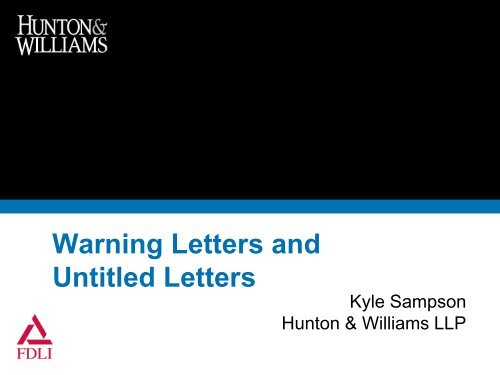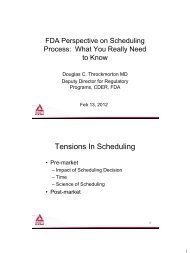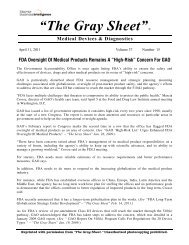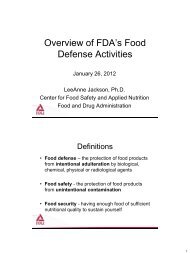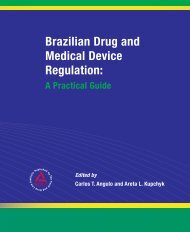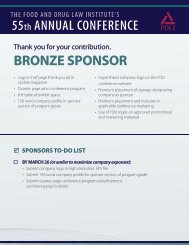Warning Letters and Untitled Letters
Warning Letters and Untitled Letters
Warning Letters and Untitled Letters
You also want an ePaper? Increase the reach of your titles
YUMPU automatically turns print PDFs into web optimized ePapers that Google loves.
Definitions• <strong>Untitled</strong> <strong>Letters</strong>– Initial correspondence with regulated industrythat cites violations that do not meet thresholdfor a <strong>Warning</strong> Letter– For circumstances where FDA needs tocommunicate with industry, but may not beprepared to take enforcement action3
History• Background– Prior to 1991, FDA issued “Notices ofAdvanced Findings/Regulatory <strong>Letters</strong>”– In 1991, FDA began issuing <strong>Warning</strong> <strong>Letters</strong><strong>and</strong> <strong>Untitled</strong> <strong>Letters</strong>– In 2001, procedures were changed so that all<strong>Warning</strong> <strong>Letters</strong> had to be reviewed <strong>and</strong>cleared by FDA’s Office of the Chief Counsel– In 2009, OCC review was limited to lettersthat present significant legal issues4
Importance• Importance of <strong>Warning</strong> <strong>Letters</strong> to FDA– Half of Commissioner Hamburg’s Six Steps toIncreased Enforcement• Speed up the <strong>Warning</strong> Letter process –Decentralize issuance of <strong>Warning</strong> <strong>Letters</strong> bylimiting OCC review• Prioritize follow-up on <strong>Warning</strong> <strong>Letters</strong> – Quicklyassess <strong>and</strong> follow-up on corrective actions takenby firms in response to a <strong>Warning</strong> Letter• Implement <strong>Warning</strong> Letter close-out process – Iffirms take corrective action, issue a Close-OutLetter <strong>and</strong> post it on the FDA website5
Format• Common Elements– Title: “WARNING LETTER”– Addressed to highest known official in the firm• If <strong>Warning</strong> Letter concerns inspectional findings, acopy is sent to highest known official at facility– Dates of inspection; a description of violativeproduct, practice, or process; <strong>and</strong> citation tolaw or regulation violated– Dem<strong>and</strong> that corrective action be taken, <strong>and</strong>that a written response be provided within 15days6
Format• Additional Common Elements– <strong>Warning</strong> that failure to correct the violationsmay result in enforcement action– Statement about the implications for theawarding of federal contracts– Instructions on the firm’s response, including:• Listing each step taken to completely correct theviolations <strong>and</strong> prevent future violations• The time for completion of the corrective actions• Documentation showing that corrections havebeen made7
Prior Notice• Prior Notice– In general, FDA’s policy is to provide awarning prior to taking enforcement action,but FDA has no legal obligation to do so– FDA will take immediate enforcement action if• Violations reflects a history of repeated orcontinued violative conduct• Violations are intentional or flagrant• Violations present a reasonable possibility of injuryor death• Adequate notice has been given by other means,<strong>and</strong> violations have not been corrected8
Significance• Significance of Receiving a <strong>Warning</strong> Letter– <strong>Warning</strong> <strong>Letters</strong> are issued only for violationsof regulatory significance• Significant violations are violations that may lead toenforcement action if not adequately corrected• Which violations are significant?– <strong>Warning</strong> <strong>Letters</strong> are FDA’s principal means ofachieving prompt, voluntary compliance– <strong>Warning</strong> <strong>Letters</strong> are posted to FDA’s website9
Significance• Significance of Receiving an <strong>Untitled</strong> Letter– <strong>Untitled</strong> <strong>Letters</strong> cite violations that do notmeet the threshold of regulatory significanceof a <strong>Warning</strong> Letter• The letter is not titled• The letter does not include a warning that failure totake corrective action may result in enforcementaction• The letter requests (rather than requires) a writtenresponse within a reasonable amount of time10
Avoidance• How to Avoid Receiving a <strong>Warning</strong> Letter– Adopt a compliance program modeled onHHS’s OIG Compliance Program Guidancefor Pharmaceutical Manufacturers– Implement st<strong>and</strong>ard operating procedures– Conduct training on the compliance program’spolicies <strong>and</strong> procedures, as well as SOPs– Establish a committee to review <strong>and</strong> approveall promotional materials– Respond promptly <strong>and</strong> thoroughly to anyinspectional observations11
Recovery• How to Recover After Receiving a <strong>Warning</strong>Letter– Obtain advice from competent FDA regulatorycounsel– Request a meeting with appropriate FDApersonnel– Take corrective action promptly– Submit a thorough response to the <strong>Warning</strong>Letter <strong>and</strong>, when appropriate, ask that theresponse be posted on FDA’s website12
Close-Out <strong>Letters</strong>• Close-Out Process– FDA will issue a Close-Out Letter if• The firm’s response to the <strong>Warning</strong> Letter providedsufficient information to show that the violationshave been adequately corrected• A follow-up inspection confirms that correctiveactions were adequate (or, based on otherinformation, FDA determines that a follow-upinspection is not necessary)• The follow-up inspection (or other information) doesnot reveal other significant violations– Close-Out <strong>Letters</strong> are posted to FDA’s website13
Thank you!14


